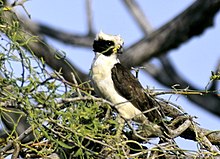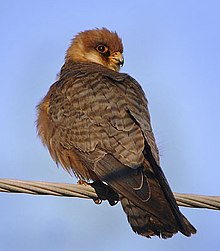
Description
Falcons and caracaras are small to medium-sized birds of prey, ranging in size from the black-thighed falconet, which can weigh as little as 35 grams (1.2 oz), to the gyrfalcon, which can weigh as much as 1,735 grams (61.2 oz). They have strongly hooked bills, sharply curved talons and excellent eyesight. The plumage is usually composed of browns, whites, chestnut, black and grey, often with barring of patterning. There is little difference in the plumage of males and females, although a few species have some sexual dimorphism in boldness of plumage.Distribution and habitat
The family has a cosmopolitan distribution across the world, absent only from the densest forest of central Africa, some remote oceanic islands, the high Arctic and Antarctica. Some species have exceptionally wide ranges, particularly the cosmopolitan peregrine falcon, which ranges from Greenland to Fiji and has the widest natural breeding distribution of any bird. Other species have more restricted distributions, particularly island endemics like the Mauritius kestrel. Most habitat types are occupied, from tundra to rainforest and deserts, although they are generally more birds of open country and even forest species tend to prefer broken forest and forest edges. Some species, mostly in the genus Falco, are fully migratory, with some species summering in Eurasia and wintering entirely in Africa, other species may be partly migratory. The Amur falcon has one of the longest migrations, moving from East Asia to southern Africa.[1]Behaviour
Diet and feeding
The laughing falcon is a snake-eating specialist
Breeding
The red-footed falcon is unusual in being a colonial breeding falcon
Relations with humans
Falcons and caracaras have a complicated relationship with humans. In ancient Egypt they were deified in the form of Horus, the sky and sun god who was the ancestor of the pharaohs. Caracaras also formed part of the legends of the Aztecs, and are today the national emblems of Mexico. Falcons were important in the (formerly often royal) sport of falconry. They have also been persecuted for their predation on game and farm animals, and that persecution has led to the extinction of at least one species, the Guadalupe caracara. Several insular species have declined dramatically, none more so than the Mauritius kestrel, which at one time numbered no more than four birds. Around five species of falcon are considered vulnerable to extinction by the IUCN, including the saker falcon.Taxonomy and systematics
The family Falconidae was introduced by the English zoologist William Elford Leach in a guide to the contents of the British Museum published in 1820.[5][6]Families
Traditionally, the raptors were grouped into four families in the single order Falconiformes, but many thought this group to be paraphyletic and not to share a common ancestor to the exclusion of all other birds.First, multiple lines of evidence in the 1970s and 1980s suggested that the New World vultures Cathartidae were closer related to storks and herons (Ciconiiformes), though more recent place them outside that group as well. Consequently, New World vultures are now often raised to the rank of an independent order Cathartiformes not closely associated with either birds of prey or storks or herons.[7] In 2007, the American Ornithologists' Union's North American checklist moved Cathartidae back into the lead position in Falconiformes, but with an asterisk that indicates it is a taxon "that is probably misplaced in the current phylogenetic listing but for which data indicating proper placement are not yet available".[8]
In Europe, it has become common to split the remaining raptors into two: the falcons and caracaras remain in the order Falconiformes (about 60 species in 4 groups), and the remaining 220-odd species (including the Accipitridae – eagles, hawks, Old World vultures, etc.) are put in the separate order Accipitriformes. An unplaced prehistoric family known only from fossils are the Horusornithidae.
In agreement with the split of Falconiformes and Accipitriformes, comparative genome analysis published in 2008 suggested that falcons are more closely related to the parrots and passerines than to other birds including the Accipitridae, so that the traditional Falconiformes are paraphyletic even if the Cathartidae are excluded.[9] Indeed, a 2011 analysis of transposable element insertions shared between the genomes of falcons, passerines, and parrots, but not present in the genomes of other birds, confirmed that falcons are a sister group of the combined parrot/passerine group, together forming the clade Eufalconimorphae.[10]
Subfamilies
The clade Falconidae is composed of three main branches: the falconets and true falcons, the caracaras, and the forest falcons. Differences exist between authorities in how these are grouped into subfamilies. Also, the placement of the laughing falcon (Herpetotheres) and the spot-winged falconet (Spiziapteryx) varies.One common approach uses two subfamilies Polyborinae and Falconinae. The first contains the caracaras, forest falcons, and laughing falcon. All species in this group are native to the Americas.[11]
The composition of Falconidae is disputed, and Polyborninae is not featured in the American Ornithologists' Union checklists for North and South American birds that are produced by its Classification Committees (NACC and SACC). The Check-list of North American Birds considers the laughing falcon a true falcon (Falconinae) and replaces Polyborinae with Caracarinae and Micrasturinae.[12] On the other hand, the Check-list of South American Birds classifies all caracaras as true falcons and puts the laughing falcon and forest falcons into the subfamily Herpetotherinae.[13]
Based on genetic research from the late 1990s to 2015, Boyd[14] uses three subfamilies. He places the laughing falcon (Herpetotheres) with the forest falcons (Micrastur) into Herpetotherinae (similar to SACC). Caracarinae is separate (similar to NACC), but also contains the spot-winged falconet (Spiziapteryx). The other falcons are placed in Falconinae.
Falconinae, in its traditional classification, contains the falcons, falconets, and pygmy falcons.[15] Depending on the authority, Falconinae may also include the caracaras and/or the laughing falcon.[13][16] Boyd further divides the Falconinae into two tribes: Polyhieracini containing the Microhierax falconets, plus Falconini containing the Falco falcons. The pygmy falcon and the white-rumped (pygmy) falcon are split into separate genera (Polyhierax and Neohierax), with the former placed into Polyhieracini and the latter into Falconini.[14]


No comments:
Post a Comment
Note: Only a member of this blog may post a comment.